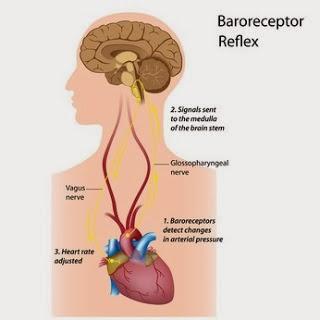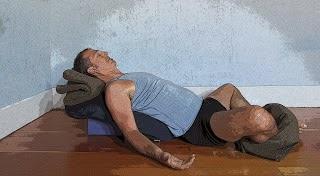 If you have high blood pressure—or even high blood pressure that is being controlled with medication as Timothy wrote yesterday—there are certain anti-stress poses that you should not be doing. Although inverted poses can lower blood pressure due to the interaction between your baroreceptors and your nervous system (see Why You Should Love Your Baroreceptors), going upside down initially raises your blood pressure before feedback from the baroreceptors to the nervous system causes the Relaxation Response to kick in. This initial rise in blood pressure is why the poses are considered dangerous for those whose blood pressure is already high (and perhaps for those whose blood pressure is being controlled with medication as Timothy wrote in Keeping Yoga Safe for People with High Blood Pressure), because there is concern it could cause a stroke.
If you have high blood pressure—or even high blood pressure that is being controlled with medication as Timothy wrote yesterday—there are certain anti-stress poses that you should not be doing. Although inverted poses can lower blood pressure due to the interaction between your baroreceptors and your nervous system (see Why You Should Love Your Baroreceptors), going upside down initially raises your blood pressure before feedback from the baroreceptors to the nervous system causes the Relaxation Response to kick in. This initial rise in blood pressure is why the poses are considered dangerous for those whose blood pressure is already high (and perhaps for those whose blood pressure is being controlled with medication as Timothy wrote in Keeping Yoga Safe for People with High Blood Pressure), because there is concern it could cause a stroke.Timothy didn’t list exactly which inverted poses besides Headstand that people with high or even controlled high blood should be avoiding, so I decided to talk with Baxter about the topic in order to list them out for you. The good news is that Baxter considers three of the most effective stress-reducing inversions to be generally safe. I’ve divided the inverted poses into same three groups I used in my post All About Supported Inversions. So here goes:
Full Inversions: Poses to Avoid
- Handstand (Adho Mukha Vrksasana)
- Forearm Balance (Pincha Mayurasana)
- Scorpion (Vrschikasana)
- Headstand (Sirsasana)
- Shoulderstand (Sarvagasana), including the chair version
- Plow (Halasana), including the chair/bench version
Half Inversions: Poses to Evaluate
- Downward-Facing Dog pose (Adho Mukha Svanasana)
- Standing Forward Bend (Uttanasana), with or without support
- Wide-Legged Standing Forward Bend (Prasarita Padottanasana)
“Does the student appear to have the strength and flexibility to do the pose safely? How is their breathing in the pose? Do they look uncomfortable? Are they able to maintain a healthy curve in the neck? Are their neck veins bulging? How do they say they feel in the pose? It is even possible, if you've got a blood pressure device, to measure the pressure to make sure it isn't spiking in the pose or poses you're concerned about.”
If the pose is difficult or stressful for you, you may want to exclude it from your practice. If you decide to exclude these poses, you can practice Half Downward-Facing Dog pose at the Wall instead.
Gentle Inversions: Poses that are Generally Safe
- Legs Up the Wall pose (Viparita Karani)
- Easy Inverted pose (Viparita Karani with bent legs)
- Supported Straight Leg Bridge pose (Setubanda Sarvangasana)
Safe Ways to Lower Blood Pressure
 Remember, there is no need for you to do any inverted poses! If you are at all concerned about going upside down, you can choose from several other very effective and safe techniques for lowering your blood pressure. Any yoga or meditation technique that triggers the Relaxation Response (see The Relaxation Response and Yoga) will lower your blood pressure (this was proven in the 70s by Dr. Herbert Bensen and described in his book The Relaxation Response, which I highly recommend). Probably the easiest thing to do is just to sit quietly and observe your breath or recite a mantra. But you can practice any form of mediation, practice Yoga Nidra, any guided Savasana, or any form of Relaxation pose (Savasana) with a mental focus. You could also practice your favorite restorative poses (see Mini Restorative Practice, also with a mental focus. Just be sure to take a non-judgmental attitude toward your practice, give yourself at least 10 to 20 minutes of practice, as it takes a while for the Relaxation Response to kick in, and don’t fall asleep (sleeping is different than conscious relaxation).
Remember, there is no need for you to do any inverted poses! If you are at all concerned about going upside down, you can choose from several other very effective and safe techniques for lowering your blood pressure. Any yoga or meditation technique that triggers the Relaxation Response (see The Relaxation Response and Yoga) will lower your blood pressure (this was proven in the 70s by Dr. Herbert Bensen and described in his book The Relaxation Response, which I highly recommend). Probably the easiest thing to do is just to sit quietly and observe your breath or recite a mantra. But you can practice any form of mediation, practice Yoga Nidra, any guided Savasana, or any form of Relaxation pose (Savasana) with a mental focus. You could also practice your favorite restorative poses (see Mini Restorative Practice, also with a mental focus. Just be sure to take a non-judgmental attitude toward your practice, give yourself at least 10 to 20 minutes of practice, as it takes a while for the Relaxation Response to kick in, and don’t fall asleep (sleeping is different than conscious relaxation). All of these options are wonderful for anyone who experiences “situational” high blood pressure (when getting stressed out or angry causes... well, you know!) And practicing conscious relaxation on a regular basis will also enhance your health in the short term (bolstering your immune system) and the long term (helping to prevent heart disease, strokes, and other diseases of aging).

